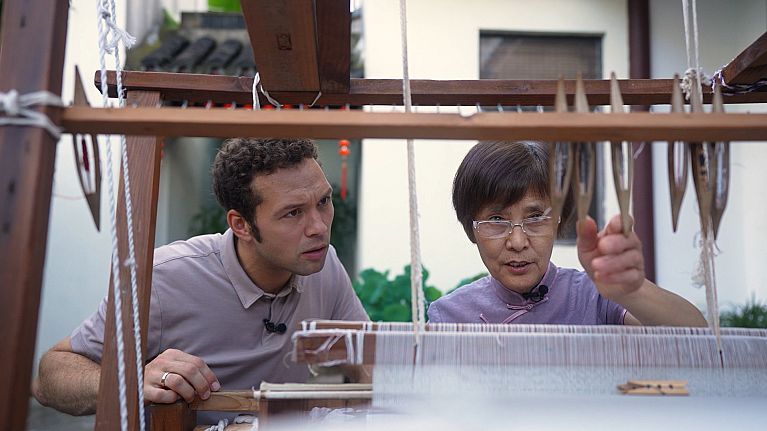Travel
Microsoft pitches AI agents that can perform tasks on their own at annual Ignite event
The move has been criticised by other tech companies who have branded Microsoft as being a “panic mode”.
In opening remarks to a company conference in the United States on Tuesday, Microsoft CEO Satya Nadella has set the stage for where the company is taking its artificial intelligence (AI) business.
AI developers are increasingly pitching the next wave of generative AI (GenAI) chatbots as AI “agents” that can do more useful things on people’s behalf.
But the cost of building and running AI tools is so high that more investors are questioning whether the technology’s promise is overblown.
Microsoft said last month that it’s preparing for a world where “every organisation will have a constellation of agents – ranging from simple prompt-and-response to fully autonomous”.
Microsoft elaborated in a blog post Tuesday that such autonomous agents “can operate around the clock to review and approve customer returns or go over shipping invoices to help businesses avoid costly supply-chain errors”.
Microsoft’s annual Ignite conference caters to its big business customers.
Microsoft criticised
The pivot toward so-called “agentic AI” comes as some users are seeing limits to the large language models behind chatbots like OpenAI’s ChatGPT, Google’s Gemini and Microsoft’s own Copilot.
Those systems work by predicting the most plausible next word in a sentence and are good at certain writing-based work tasks.
But tech companies have been working to build AI tools that are better at longer-range planning and reasoning so they can access the web or control computers and perform tasks on their own on a user’s behalf.
Salesforce CEO Marc Benioff has criticized Microsoft’s pivot. Salesforce also has its “Agentforce” service that uses AI in sales, marketing, and other tasks.
“Microsoft rebranding Copilot as ‘agents’? That’s panic mode,” Benioff said in a social media post last month. He went on to claim that Microsoft’s flagship AI assistant, called Copilot, is “a flop” that is inaccurate and spills corporate data.
Travel
Discovering cultural connections through gardens: France’s grandeur meets China’s serene beauty

Discovering cultural connections through gardens: France’s grandeur meets China’s serene beauty
In partnership with

Copyright euronews
Copyright euronews
Published on •Updated
Share this article
Copy/paste the article video embed link below:Copied
In this episode of Crossing Cultures, we explore two iconic garden models – a grand French masterpiece and a tranquil Chinese oasis – to discover how nature and design reflect the cultural identities that shaped them.
Gardens are more than spaces of beauty; they reveal cultural philosophies and identities.
This episode of Crossing Cultures explores France’s Vaux-le-Vicomte and China’s Humble Administrator’s Garden. Designed by André Le Nôtre, Vaux-le-Vicomte exemplifies the ambition and symmetry of 17th-century France and influenced the grandeur of Versailles.
In Suzhou, the Humble Administrator’s Garden embraces natural flow and asymmetry, reflecting the unity between man and nature.
While French gardens demonstrate strength and precision, Chinese gardens emphasise harmony and poetic meaning. From structured perfection to serene landscapes, these masterpieces show how two cultures have used gardens to express their values and shape their heritage.
Go to accessibility shortcuts
You might also like

Now playing

Now playing

Now playing
Travel
Israel’s forced displacement in Gaza is a crime against humanity
The opinions expressed in this article are those of the author and do not represent in any way the editorial position of Euronews.
The rest of the world needs to step in and stand up for the law and the human beings these laws are meant to protect. This shouldn’t be allowed to get worse. It needs to stop now, HRW’s Nadia Hardman writes.
Removing civilians from harm’s way in advance of an attack is the right thing for warring parties to do if it’s the only way to protect them. But the laws of war stipulate that this can only be done in narrow circumstances as a temporary measure, and civilians should be given a safer location where their humanitarian needs are met.
Israel claims its evacuation orders in Gaza have done just that.
Not so.
Israeli military actions have utterly failed to keep fleeing and displaced Palestinians in Gaza safe and, in fact, have put them in danger.
We analysed 184 Israeli military evacuation orders and dozens of satellite images and found that inaccurate and inconsistent evacuation orders often served only to sow confusion and spread fear, if they even came in time to allow people to flee at all. The Israeli military repeatedly designated evacuation routes and safe zones — and then attacked them.
A 42-year-old woman with an 11-year-old son said, “Yes, the leaflets and recorded calls were what I understood to be evacuation orders, and yes, we wanted to follow them, but could not because the Israelis started bombing the area heavily even before the announcement. People were killed in huge numbers and in brutal ways.”
Things were no safer on her evacuation route. “There were airstrikes while we were walking but we followed people and survived.”
On 10 November 2023, Prime Minister Benjamin Netanyahu declared, “We have established a safe zone.” The reality was the opposite.
‘We are living an animal life’
A 34-year-old man who was displaced with his children from Gaza City told me that he first fled south to a supposedly safe area in Khan Younis. “The Israelis said Khan Younis was a safe place,” he said. “But they started bombing this area … I took a decision to leave and go to Rafah.”
The man and his family sought refuge in the so-called “humanitarian zone” in al-Mawasi, staying in a small tent near the beach. He said an Israeli airstrike hit a building near a humanitarian agency approximately 300 meters from his tent.
“The emotional state of the kids, what they witnessed in the last area — they are in shock, they are terrified,” he said. “They jump at small sounds now. It was so hard for me to get my family from the last place to here. Most of the areas were closed by the Israelis as they were considered battle areas.”
Under international law, safe areas are required to be — of course — safe, but displaced people must also have access to food and water, health care, sanitation, and shelter.
But this man told me that he and his family had been sleeping on the ground in a tent with 10 others, using a shared outdoor toilet serving about 70-80 people and that humanitarian aid, so far, had consisted of two bags of flour. “We are living an animal life,” he said.
The laws of war also require evacuation to be temporary. Israel is duty-bound to facilitate the displaced person’s return to their home as soon as possible after the end of the hostilities in the area.
But the Israelis have reduced many of the displaced civilians’ home areas to rubble, intentionally or recklessly destroying or severely damaging swaths of housing and civilian infrastructure — including controlled demolitions after hostilities have largely ceased.
Step in and stand up for the law
The intentional forced displacement of a civilian population in an occupied territory is a war crime. Nowhere is this organised, deliberate displacement clearer than in areas of Gaza that have been razed, extended, and cleared for buffer zones along the border with Israel and in a security corridor that bifurcates Gaza.
The intention of the Israeli authorities appears to be to permanently empty and cleanse these areas of Palestinians and keep them under the occupation and control of Israel.
Multiple statements by senior Israeli officials show that the forced displacement in Gaza is intentional and is Israeli state policy. Because it is also widespread and systematic, this forced displacement qualifies not only as a war crime but as a crime against humanity, which the International Criminal Court‘s prosecutor should investigate.
We can expect these crimes against Palestinians to continue unless and until Israel’s allies demand for it to end.
US President-elect Donald Trump is likely to empower Israel to double down, given that he said on the campaign trail that it should “finish the job”.
That leaves the rest of the world to step in and stand up for the law and the human beings these laws are meant to protect. This shouldn’t be allowed to get worse. It needs to stop now.
Nadia Hardman is a researcher at Human Rights Watch and author of “Hopeless, Starving, and Besieged: Israel’s Forced Displacement of Palestinians in Gaza”.
Travel
Billionaires, frequent flyers, oil and gas: Who could fund COP29’s $1tn finance target?
“It makes common sense to tax mega polluters and the mega-rich to ensure that we have the money needed for climate action at home and globally” according to one campaigner.
Who should foot the climate finance bill – from loss and damage funds to new funding targets – has become an enduring controversy at recent COPs.
Experts have said that at least $1 trillion (€948 billion) needs to flow to developing nations by 2030 and a new climate finance goal known as the new collective quantified goal (NCQG) hangs in the balance in Baku.
Rich countries are calling for the pool of contributors to be widened. As developing nations deal with the growing frequency and scale of climate disasters, the urgency for these funds increases.
There are big gaps that rich nations will need to fill with innovative forms of finance. From levies on high carbon activities to wealth taxes, what are some of the alternative ideas on the table for raising this cash?
Simple solutions or difficult diplomacy?
A study published by civil society group Oil Change International in September found that rich countries could raise five times the money developing nations are demanding in climate finance with a series of what it calls “simple measures”.
According to the study, a combination of wealth and corporate taxes, taxes on fossil fuel extraction and a crackdown on subsidies could generate $5 trillion (€4.7 trillion) a year – five times what developing nations say they need.
Stopping fossil fuel subsidies alone could free up $270 billion (€256 billion) in rich countries and a tax on fossil fuel extraction could raise $160 billion (€152billion). A frequent flyer levy could total $81 billion (€77 billion) a year from the rich world and increasing wealth taxes on multimillionaires and billionaires would raise a staggering $2.56 trillion (€2.43 trillion). In total, the list of measures it proposes would raise $5.3 trillion (€5.02 trillion) a year.
Some of these options are likely to be easier to implement than others. While adding a levy for frequent fliers doesn’t seem that controversial, money talks and strong opposition from billionaires could stop a wealth tax in its tracks.
Another proposal, redistributing 20 per cent of public military spending to raise $260 billion (€246 billion), could also prove tricky in a world of growing geopolitical instability.
Could a billionaire tax help pay the climate finance bill?
In July, a meeting of G20 finance ministers in Rio agreed to a “dialogue on fair and progressive taxation, including of ultra-high-net-worth individuals”. Brazilian President Luiz Inacio Lula da Silva is hoping to progress talks on this potential billionaire tax at the G20 meeting this week.
The baseline proposal from the finance ministers of Brazil, Germany, Spain and South Africa earlier this year recommended a 2 per cent tax on roughly 3,000 individuals with a net worth of more than $1 billion (€946 million). This would raise around €230 billion a year to fight poverty, inequality – and the climate crisis.
It has broad public support in G20 nations with an Ipsos poll from June showing that 70 per cent of people back the idea that wealthy people should pay higher income tax rates. But as G20 leaders meet in Brazil this week, there are reports that negotiators from Argentina’s new right-wing government are trying to undo progress made on this agreement.
“There is huge popular support in the G20 countries for a tax on the super-rich and it is important that the European countries in the G20 rally behind the Brazillian President to protect the unprecedented agreement on taxing extreme wealth achieved by the finance ministers in July,” says Kate Blagojevic, associate director of Europe campaigns at 350.org.
“It makes common sense to tax mega polluters and the mega-rich to ensure that we have the money needed for climate action at home and globally, which can prevent and repair damage from extreme weather like we have seen in Spain and in Central America over the last few weeks.”
Other countries have not been keen to criticise the proposal in public but many fear that announcing such a tax would cause these ultra-wealthy individuals to flee to nations with more attractive tax policies.
Spain’s economy minister Carlos Cuerpo urged countries on Monday before the G20 meeting to “be brave” and “do things that you are convinced are right”.
Could taxing big oil help pay the climate finance bill?
A small tax on just seven of the world’s biggest oil and gas companies would grow the UN’s Loss and Damage fund by more than 2,000 per cent, according to a new analysis published today by Greenpeace International and Stamp Out Poverty.
It says that introducing what it calls a Climate Damages Tax across OECD countries could play an essential role in financing climate action. This is described as a fossil fuel extraction charge applied to the carbon dioxide equivalent emissions of each tonne of coal, barrel of oil or cubic metre of gas produced.
A tax starting at $5 (€4.74) – and increasing year-on-year – per tonne of carbon emissions based on the volumes of oil and gas extracted by each company would raise an estimated $900 billion (€853 billion) by 2030, it finds. The two groups say this money would support governments and communities around the world as they face growing climate impacts.
“Who should pay? This is fundamentally an issue of climate justice and it is time to shift the financial burden for the climate crisis from its victims to the polluters behind it,” says Abdoulaye Diallo, co-head of Greenpeace International’s Stop Drilling Start Paying campaign.
Diallo adds that the analysis lays bare the scale of the challenge posed by the requirement for loss and damage funding “and the urgent need for innovative solutions to raise the funds to meet it”.
Could taxing frequent fliers help Europe raise climate finance funds?
In Europe, a tax on frequent fliers could raise €64 billion and slash emissions by a fifth, according to a report from environmental campaign groups Stay Grounded and the New Economics Foundation (NEF) published in October.
Currently, regardless of how many times a year you fly, you pay the same amount of aviation tax. But the report proposes an increasing level of tax for each flight a person takes in a year.
It would be added to all trips departing from the European Economic Area (EEA) and the UK, excluding the first two journeys. There would also be a surcharge on the most polluting medium and long-haul flights as well as business and first-class seats.
For the first and second flights taken in a year, a €50 surcharge would be applied to medium-haul and €100 to long-haul, business and first-class flights. For the third and fourth flights, a €50 levy would be added to every ticket plus an additional €50 surcharge for medium-haul and €100 for longer distances and comfort classes.
For fifth and sixth flights, the levy would rise to €100 per flight, plus the additional surcharges. For seventh and eighth flights the levy would be €200, rising to €400 for every flight thereafter.
In a way, this is also a kind of wealth tax. Five per cent of households earning over €100,000 take three or more return flights a year versus just 5 per cent of households earning less than €20,000.
A portion of these funds, according to senior researcher at NEF Sebastian Mang, should be ringfenced for the EU’s contribution to lower and middle-income countries dealing with the sharp end of the climate crisis.
-

 EU & the World4 days ago
EU & the World4 days agoAlex Jones’ Net Worth: How Much Money the ‘Infowars’ Creator Has Now
-

 EU & the World4 days ago
EU & the World4 days agoJake Paul’s Girlfriend: 5 Things to Know About Jutta Leerdam
-
EU & the World4 days ago
‘Better Man’ Movie Starring Robbie Wiliams: Release Date, Trailer & More
-

 EU & the World4 days ago
EU & the World4 days agoWhere to Watch the Jake Paul vs. Mike Tyson Fight
-

 Sports4 days ago
Sports4 days agoMike Tyson slaps Jake Paul: all set for the match
-

 Sports5 days ago
Sports5 days agoAre the Finals staying in Turin? Zverev reveals, “I already know everything but I’m not telling you anything.”
-

 EU & the World5 days ago
EU & the World5 days agoDoes Matt Gaetz Have Kids? About Trump’s Attorney General Nominee’s Family
-

 EU & the World4 days ago
EU & the World4 days agoWho Is the New Senate GOP Leader? About the Successor to Mitch McConnell








